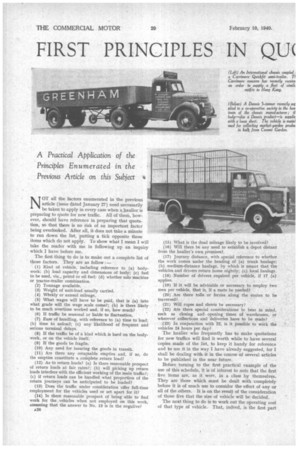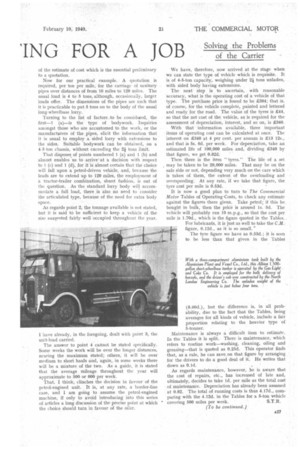FIRST PRINCIPLES IN QU( ING FOR A JOB
Page 36

Page 37

If you've noticed an error in this article please click here to report it so we can fix it.
Solving the Problems of the Carrier
A Practical Application of the Principles Enumerated in the Previous Article on this Subject t NOT all the factors enumerated in the previous article (issue dated January 27) need necessarily be taken to apply in every case when a haulier is preparing to quote for new traffic. All of them, however, should have reference in preparing that quotation, so that there is no risk of an important factor being overlooked. After all, it does not take a minute to run down the list, putting a tick opposite those items which do not apply. To show what I mean I will take the reader with me in following up an inquiry which I have before me.
The first thing to do is to make out a complete list of those factors. They are as follow : —
( i) Kind of vehicle, including reference to (a) bodywork; (b) load capacity and dimensions of body; (c) fuel to be used, viz., petrol or oil fuel: (d) whether solo machine or tractor-trailer combination.
(2) Tonnage available.
(3) Weight of unit-load usually carried.
(4) Wtekly or annual mileage.
(5) What wages will have to be paid, that is (a) into what grade will the wage scale come?; (b) is there likely
to be much overtime worked and, if so, how much? .
(6) If traffic be seasonal or liable to fluctuation.
(7) Ease of handling, with reference to (a) time to load;
(b) time to unload; (c) any likelihood of freqUent and serious terminal delays.
(8) If the traffic be of a kind which is hard on the bodywork, or on the vehicle itself.
(9) If the goods be fragile.
(10) Any need for insuring the goods in transit.
(I1) Are there any returnable empties and, if so, do the empties constitute a complete return load?
(12) As to return loads? (a) Is there reasonable prospect of return loads at fair rates?; (b) will picking up return loads interfere with the efficient working of the main traffic?; (c) if return loads can be handled what proportion of the return journeys can be anticipated to be loaded?
(13) Does the traffic under consideration offer full-time employment for the vehicles used or set apart for it?
(14) Is there reasonable prospect of being able to find work for the .vehicles when not employed on this work, assuming that the answer to No. 13 is in the negative?
A26 (15) What is the dead mileage likely to be involved?
(16) Will there be any need to establish a depot distant from the haulier's own premises?
(17) Journey distance, with special reference to whether the work comes under the heading of (a) trunk haulage; (b) medium-distance haulage, by which is meant that the vehicles and drivers return home nightly; (c) local haulage.
(18) Number of drivers required per vehicle, if 17 (a) applies.
(19) If it will be advisable or necessary to employ two men per vehicle, that is, if a mate be needed?
(20) Are there tolls or ferries along the routes to be traversed?
(21) Will ropes and sheets be necessary?
(22) Are there special considerations to bear in mind, such as closing and, opening times of warehouses, or wherever collections and deliveries have to be made?
(23) In conjunction with 22, is it possible to work the vehicles 24 hours per day?
The haulier who frequently has to make quotations for new traffics will find it worth while to have several copies made of the list, to keep it handy for reference and to use it in the way I have already suggested, for I shall be dealing with it in the course of several articles to be published in the near future.
Before turning to the first practical example of the use of this schedule, it is of interest to note that the first five items are, as it were, in a class by themselvs. They are those which must be dealt with completely before it is of much use to consider the effect of any or all of the others. It is on the result of the consideration of those five that the size of vehicle will be decided.
The next thing to do is to work out the operating cost of that type of vehicle.That, indeed, is the first part
of the estimate of cost which is the essential preliminary to a quotation.
Now for our practical example. A quotation is required, per ton per mile, for the carriage of sanitary pipes over distances of from 16 miles to 120 miles. The usual load is 4 to 5 tons, although, occasionally, larger loads offer. The dimensions of the pipes are such that it is practicable to put 5 tons on to the body of the usual long-wheelbase lorry.
Turning to the list of factors to be considered, the first-1 (a)—is the type of bodywork. Inquiries amongst those who are accustomed to the work, or the manufacturers Of the pipes, elicit the information that it is usual to employ a sided lorry with extensions to the sides. Suitable bodywork can be obtained, on a 4-5-ton chassis, without exceeding the 2* tons limit.
That disposes of points numbered 1 (a) and 1 (b) and almost enables us to arrive at a decision with respect to I (c) and 1 (d), for it is almost certain that the choice will fall upon a petrol-driven vehicle, and, because the leads are to extend up to 120 miles, the employment of a tractor-trailer combination, shunt fashion, is out of the question. As the standard lorry body will accommodate a full load, there is also no need to consider the articulated type, because of the need for extra body space.
As regards point 2, the tonnage available is not stated, but it is said to be sufficient to keep a vehicle of the size suggested fairly well occupied throughout the year.
I have already, in the foregoing, dealt with point 3, the unit-load carried.
The answer to point 4 cannot be stated specifically. Some weeks the work will be over the longer distances, nearing the maximum stated; others, it will be over medium to short hauls and, again, in some weeks there will be a mixture of the two. As a guide, it is stated that the average mileage throughout the year will approximate to 500 or 600 per week.
That, I think, clinches the decision in favour of the petrol-engined unit. It is, at any rate, a border-line case, and I am going to assume the petrol-engined machine, If only to avoid introducing into this series of articles a long discussion of the precise point at which the choice should turn in favour of the oiler. We have, therefore, now arrived at the stage when we can state the type of vehicle which is requisite. It is of 4-5-ton capacity, weighing under 2-i tons unladen, with sided body having extensions.
The next step is to ascertain, with reasonable accuracy, what is the operating cost of a vehicle of that type. The purchase price is found to be £384; that is, of course, for the vehicle complete, painted and lettered and ready for the road. The value of the tyres is £44, so that the net cost of the vehicle, as is required for the assessment of depreciation, interest, and so on, is £340.
With that• information available, three important items of operating cost can be calculated at once. The interest on £340 at 4 per cent, per annum is £13 12s., and that is 5s, 6d. per week. For depreciation, take an estimated life of 100,000 miles and, dividing £340 by that figure, we get 0.82d.
Then there is the item "tyres." The life of a set may be taken to be 20,000 miles. That may be on the safe side or not, depending very much on the care which is taken of them, the extent of the overloading and overspeeding. At any rate, if we take that figure, the tyre cost per mile is 0.53d.
It is now a good plan to turn to The Commercial Motor Tables of Operating-Costs, to check any estimate against the figures there given. Take petrol; if this be_ bought in bulk, then the price is around ls. 5d. The vehicle will probably run 10 m.p.g., so that the cost per mile is 1.70d., which is the figure quoted in the Tables. For lubricants, it is just as well to take the C.M. figure, 0.12d., as it is so small.'
The tyre figure we have as 0.53d.; it is seen to be less than that given in the Tables (0.60d.), but the difference is, in all probability, due to the fact that the Tables, being averages for all kinds of vehicle, include a fair proportion relating to the heavier type of 5-tonner.
Maintenance is always a difficult item to estimate.
In the Tables it is split. There is maintenance, which refers to routine work—washing, cleaning, oiling and greasing—that is quoted as 0.25d. This operator finds that, as a rule, he can save, on that figure by arranging for the drivers to do a good deal of it. He writes that down as 0.1d.
As regards maintenance, however, he is aware that the cost of repairs, etc., has increased of late and, ultimately, decides to take Id. per mile as the total cost of maintenance. Depreciation has already been assessed at 0.82. The total of running costs is thus 4.17d., comparing with the 4.12d. in the Tables for a 5-ton vehicle • covering 500 miles per week. S.T.R. (To be continued.)




























































